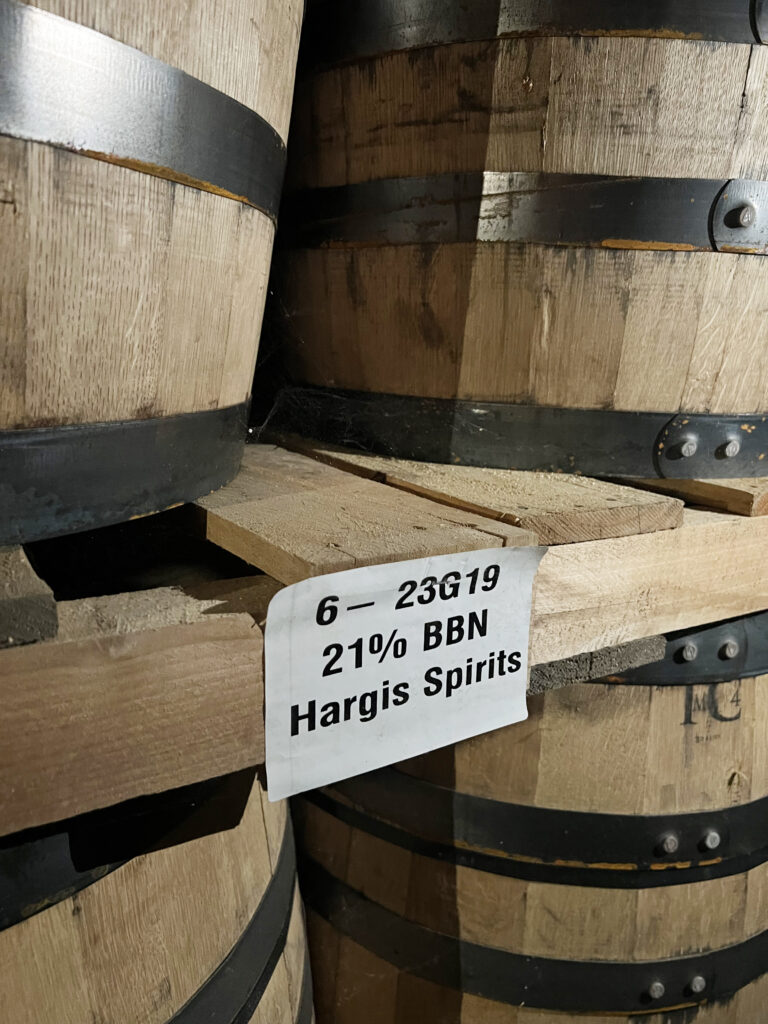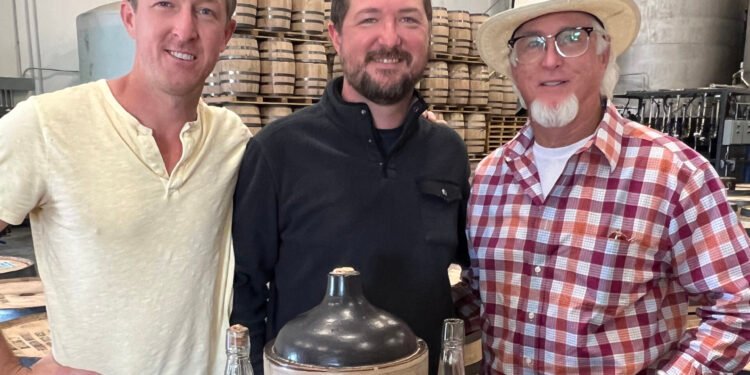Well over a century ago, a distillery operated at the eastern city limits of Henderson that made whiskey so smooth it was named Silk Velvet.
The brand was advertised in newspapers as far away as Florida and the Arizona territory during the 1880s and 1890s. Silk Velvet was clearly prized, because in one advertised pricelist for a Jacksonville mail-order liquor house, it was the priciest whiskey offered.
Its gold-and-sky-blue bottle label declared: “The finest Hand made Sour Mash Whiskey in the world.”
The Winstead family produced Silk Velvet for two generations at their distillery here; afterwards it appears to have been legally sold during Prohibition as medicinal whiskey for which a doctor’s prescription was required.
But as the years passed, the brand was largely forgotten, remembered chiefly when a dusty old Silk Velvet bottle or gallon jug was unearthed from a cellar or barn.
Until now.
The Hargis family—brothers Zach, 40, and Zeb, 37, who both work in the industry, and their father, Mark—have secured and are reviving the old Henderson brand.
The first public bottles of 21st century Silk Velvet—an estimated 250 bottles of six-year-old, 107-proof Kentucky straight bourbon from a single barrel—will go on sale online this holiday season. The whiskey will be priced at $79.99 per 750 mL bottle.
“To bring it back after 100 years of sleeping—a sleeping giant, I think—is pretty neat,” Zeb Hargis, who is district manager of the wine division in Evansville for Republic National Distributing Co., a wholesale beverage alcohol distributor, said.
Right after what the Hargises are referring to as Barrel 1 sells out, they will bottle Barrel 2, which was part of the same run of whiskey as the first barrel. In a few years, after bourbon made specifically for Silk Velvet (the first such barrels were distilled in July 2023) have aged sufficiently, the Hargises anticipate blending multiple barrels into a small-batch whiskey that they intend to be available in liquor stores.
“We want to become a national brand,” Zach said.
Silk Velvet’s story dates back to 1870, when Aaron S. Winstead moved from Daviess County to Henderson and opened a wholesale liquor business with his brother-in-law, E. W. Worsham. They operated it for several years until Worsham left the business.
Winstead remained in the wholesale liquor business and in 1880 partnered with Bona Hill, a prominent local farmer, to open the Hill & Winstead distillery in a former railroad car plant along the train tracks at the end of First Street—the site of current-day Winstead Avenue—and began producing Silk Velvet. Hill eventually retired from the business, which in 1891 became Winstead Distilling Co.
Colonel Winstead, as he was known, brought in his sons, Clarence S. and Elijah W., who were later credited with “injecting new methods into the business and infusing new life as it were, to a more active enterprise,” resulting in “a most substantial growth” of the business, according to a local newspaper account. By 1892, a Sanborn fire insurance indicated production capacity had been doubled.
When the father retired in 1910, Elijah took over Winstead Distilling and began running a series of advertisements in the local newspapers featuring fanciful letters extolling the virtues of Silk Velvet. In one appearing in late March 1914, an 80-year-old “father” thanked his “son” for keeping him supplied with “that good old Silk Velvet whiskey,” which he claimed warded off pneumonia and other diseases that winter. But the old man said he had run out and asked for more “as I need it for a blood tonic in the Spring.”
The Winstead distillery, however, seemed to have been shuttered about then. A 1913 Sanborn map indicated the distillery was “not in operation,” and by 1917, newspaper reports indicated the “old Winstead distillery plant” was being used for storing tobacco, though the Hargises have business receipts indicating that Winstead was still selling whiskey that he still had in stock.
The former distillery was still be using for storing processed tobacco in 1957 when it was destroyed in a spectacular blaze.
With that, the memory of the Winstead Distillery and Silk Velvet whiskey might have vanished as well.
Flash forward some 70 years. Zach Hargis was working in the I.T. department at Green River Distilling Co. in Owensboro, where Master Distiller Jacob Call, an eighth-generation distiller, was producing some well-regarded bourbons and rye that the company was releasing under the historic Green River brand, which it had revived.
Mark Hargis, meanwhile, had gotten his hands on some old Silk Velvet memorabilia.
Around 2020, Zach and Zeb started thinking about reviving the Silk Velvet brand because of “the Henderson side of it—we’re all Henderson born and bred.”
“We thought, ‘You know, that would be really cool to see come back,’” he said. “… The nostalgia of it.”
Zach began researching and discovered that the Silk Velvet trademark was dormant. He secured rights to the brand, which he and Zeb presented to their dad that Christmas Day.
“It was the right place and the right time,” Zeb Hargis said. “We finally got permission to use the trademark in 2021.”
In the months that followed, the family began working on brand design, tweaking the vintage Silk Velvet label from more than a century ago and selecting a rounded bottle as an homage to the jugs in which Silk Velvet was once sold. They incorporated as Hargis Spirits LLC in June 2023.
Meanwhile, in early 2022, distiller Call and another Green River executive left that company to form a startup distillery, Western Kentucky Distilling Co. at Beaver Dam. Zach Hargis joined them there as director of I.T. and new-fill and warehousing manager.
Western Kentucky Distilling began operations and filled its first barrels on July 19, 2023. Some of those first-day barrels were dedicated to Hargis Spirits to be bottled as Silk Velvet in about 2029, after six or so years of aging.
But to have something to sell now, the Hargises have secured some hand-picked existing barrels of Jacob Call-distilled bourbon that have already aged six years. The mash bill is 75% corn, 21% rye and 4% malted barley, which is a popular recipe for bourbon.
At an interview at Western Kentucky Distilling for this story, the Hargises produced a pint-sized bottle of that aged bourbon from Barrel 1 for sampling; the interviewer described it as “excellent.”
Bottles from this first public release of Silk Velvet (a “very limited” release of bottles was previously offered to some family and friends) will be available starting around Thanksgiving at www.silkvelvetwhiskey.com.
“We want Hendersonians to have first dibs” on the first release, Zeb said.
Future releases could vary from the first couple of barrels. “We will not be stuck with a single mash bill,” Zach said. “We’ll find the best barrels” of Jacob Call whiskey they can secure.
“We want to deliver a unique bottle every time,” he said.
But, Zeb said, “We’re still going to be a smooth whiskey. The goal is (to have an elevated) alcohol content (of around 100 to 110 proof), but it’s still going to go down smooth.”
The upcoming Barrel 1 release “leans more on the floral side of things,” in his assessment.
“It’s approachable,” Zach said. “Someone who’s not a whiskey drinker” can appreciate it.
At $80, Zach said of the Silk Velvet price point, “We’re not a daily drinker. We’re sort of premium,” meant to be sipped neat or on ice.
“Don’t mix Coke with it,” Zeb said, laughing.
While offering a small-batch Silk Velvet that’s available year-round is the ultimate goal, “I foresee us always releasing a single-barrel (bottle), whether quarterly or yearly,” Zach said.
And a rye whiskey, in which rye, not corn, is the dominant grain in the mash bill, is possible in the future. “I love a rye,” he said.
Whatever they sell, Zach said, it will be made by Jacob Call. And it will be an homage to their hometown of Henderson.
“We’re here to tell a story,” he said, “and the story is, Silk Velvet and the Winsteads.”
Postscript: E. W. Worsham, Col. Aaron S. Winstead’s brother-in-law and former business partner, in 1881 established his own distillery on the other side of the railroad tracks that would produce a popular brand of whiskey called Kentucky Peerless. That brand vanished during Prohibition, only to be revived in Louisville in the 2010s by former Hendersonian Corky Taylor. Two weeks ago, the International Wine & Spirits Competition awarded the 2024 Bourbon Trophy to a Peerless high-rye bourbon, signifying it, by at least one measure, as the world’s best bourbon.
























